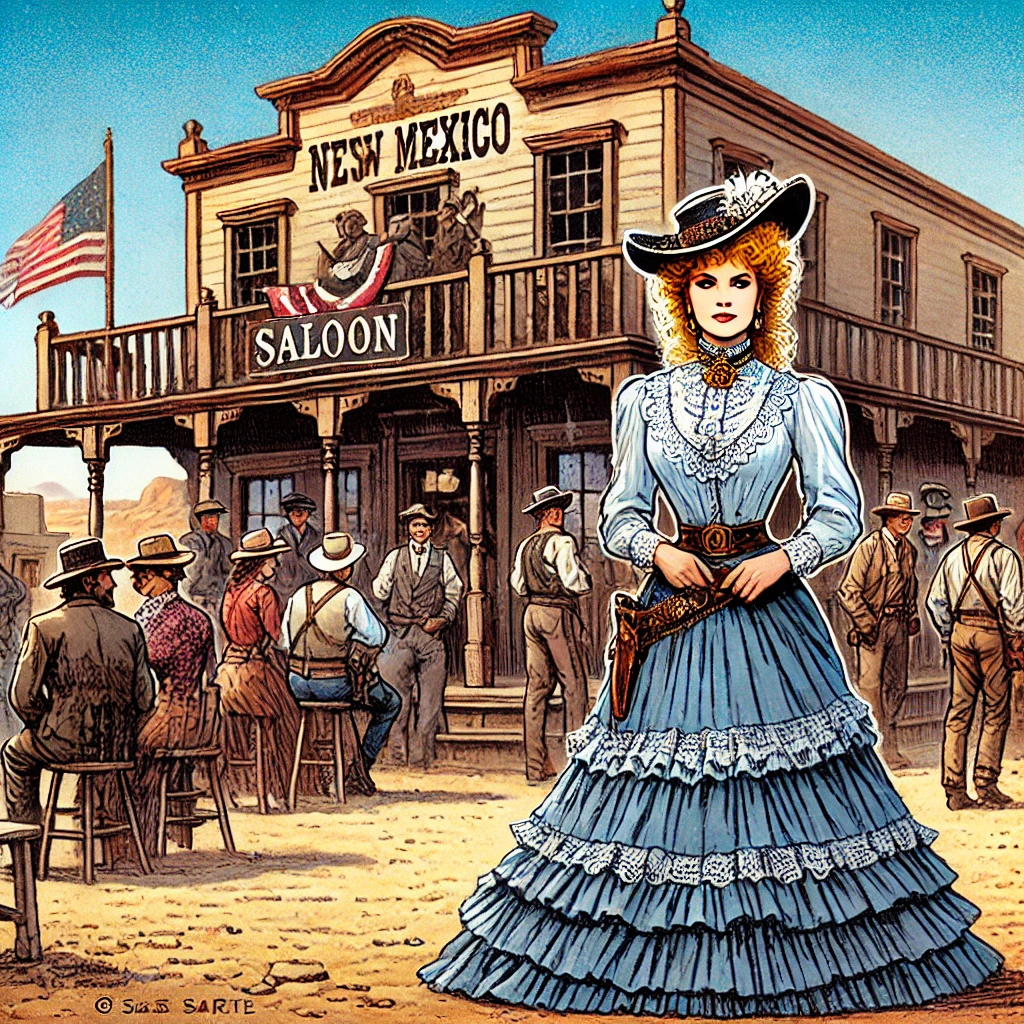Blog
The Women of Deming, NM: Inspiring the Iconic Miss Kitty of “Gunsmoke”

The television series “Gunsmoke” captivated audiences from the 1950s through the 1970s, with Miss Kitty Russell standing out as one of the show’s most iconic characters. Known for her fiery spirit, resilience, and charm, Miss Kitty was the owner of the Long Branch Saloon and the love interest of Marshal Matt Dillon. While “Gunsmoke” may have been a fictional depiction of the American West, Miss Kitty’s character was said to be inspired by real-life women who displayed courage, independence, and tenacity—traits shared by many women in Deming, New Mexico. This blog explores the lives of some of these women, shedding light on how they may have contributed to the creation of Miss Kitty.
The Spirit of the Old West: Women in Deming, NM
In the late 19th and early 20th centuries, Deming, New Mexico, was a bustling town, serving as a hub for both the Southern Pacific and Santa Fe railroads. Situated in the unforgiving desert landscape of the Southwest, Deming was filled with an eclectic mix of settlers, ranchers, businesspeople, and pioneers—many of whom were women who broke societal norms to make their mark in history. Women in Deming were known for their toughness and resourcefulness, often balancing multiple roles as caretakers, entrepreneurs, and advocates for their communities.
One such inspiring figure was Clara Brown, who ran one of the earliest boarding houses in Deming. Clara was known for her ability to provide a welcoming and safe space for travelers while managing her own business—a remarkable feat for a woman in the early 1900s. Similar to Miss Kitty, Clara was fiercely independent and played an essential role in the community by offering hospitality in an often-hostile environment. The boarding house was not just a place for lodging; it also served as a gathering place for people, much like Miss Kitty’s Long Branch Saloon.
Another influential figure was Maria Salazar, a rancher who defied gender stereotypes by running her own cattle operation. Maria grew up in Deming and took over her family’s ranch after her father’s untimely death. She demonstrated remarkable grit, managing the day-to-day operations, from negotiating sales to riding the range. Maria’s resilience and determination to succeed in a male-dominated industry echo Miss Kitty’s strength in running the saloon and holding her own in Dodge City.
The Influence of Deming Women on Miss Kitty’s Persona
The character of Miss Kitty was crafted as a symbol of female independence, a woman unafraid to forge her own path despite the societal constraints of the time. The real-life women of Deming, NM, embodied these same qualities. They refused to be confined by traditional gender roles, choosing instead to build businesses, run ranches, and serve as pillars of their communities.
Consider the life of Margaret James, a nurse who arrived in Deming during the height of the tuberculosis epidemic in the early 1900s. Margaret’s dedication to caring for the sick and her unyielding commitment to improving healthcare access in the area made her a beloved figure in Deming. Much like Miss Kitty, who often provided comfort and care to those in need, Margaret played a nurturing yet assertive role in her community. Her compassionate nature, combined with her ability to stand up to challenges, mirrors Miss Kitty’s complex character—one who could be both tender and tough when the situation demanded.
The Long Branch of Deming: Saloon Culture and Women Entrepreneurs
In the Old West, saloons were more than just drinking establishments; they were social hubs where business deals were made, friendships were forged, and the community gathered. Deming was no exception, with several saloons operated or influenced by women. Women like Annie O’Hara, who co-owned and managed the Silver Spur Saloon, challenged the prevailing notion that only men could run such establishments. Annie was known for her sharp wit, business acumen, and her ability to keep order among the rowdy patrons. She ensured her establishment was a respectable place where everyone, regardless of status, felt welcome—qualities that would later be associated with Miss Kitty’s Long Branch.
Annie’s influence can be seen in the way Miss Kitty navigated the challenges of running a saloon in a rough-and-tumble environment. Miss Kitty’s character was more than just a bar owner; she was an entrepreneur, a confidante, and a protector of those who needed help. The women of Deming, like Annie, understood that their businesses were more than a means to earn a living—they were central to the social fabric of the community.
Advocates and Leaders: Deming Women Making a Difference
Beyond business, many women in Deming also played vital roles as advocates and leaders, pushing for progress and change in their community. Take, for instance, Eleanor Chavez, a schoolteacher who fought tirelessly for the education of young girls in Deming. During a time when educating women was often seen as unnecessary, Eleanor worked to ensure that girls had access to the same quality of education as boys. Her advocacy and dedication to her students’ success drew parallels to Miss Kitty’s willingness to stand up for others, often advocating for those who were marginalized or in need of protection.
Eleanor’s courage and determination reflected Miss Kitty’s moral compass—she wasn’t just a businesswoman; she was someone who cared deeply for the well-being of her community. Miss Kitty often took risks to help others, whether by offering shelter to those in danger or by standing up to the men who sought to exploit the vulnerable. This advocacy and leadership were qualities shared by the real-life women of Deming, who worked to make their community a better place for everyone.
Miss Kitty: A Composite of Western Women
The character of Miss Kitty is a composite of many women who lived and thrived in the challenging environment of the American West. She represents the boldness, strength, and compassion that defined the women who inspired her—women like Clara Brown, Maria Salazar, Margaret James, Annie O’Hara, and Eleanor Chavez. These women, each in their own way, broke barriers and paved the way for future generations, much like Miss Kitty did on the television screen.
Their stories remind us that the West was not just shaped by cowboys and lawmen but by the women who stood beside them, ran businesses, raised families, provided care, and fought for a better future. Miss Kitty’s resilience and independence can be traced back to the real-life stories of women who refused to be limited by the expectations of their time.
The Legacy of Deming’s Women in Popular Culture
The influence of the women of Deming, NM, on Miss Kitty’s character speaks to the broader legacy of Western women in popular culture. By highlighting the real stories behind the fictional characters, we gain a deeper appreciation for the contributions of women who have often been overlooked in the telling of Western history. These women were pioneers in every sense of the word, carving out lives for themselves in a harsh and often unforgiving landscape, much like the character of Miss Kitty carved out her place in the town of Dodge.
The portrayal of Miss Kitty as a strong, independent woman who could hold her own in a male-dominated world resonated with audiences and provided a model of female empowerment at a time when such portrayals were rare on television. The real women of Deming were similarly trailblazers, challenging societal norms and creating opportunities for themselves and others. Their legacy lives on not only in the character of Miss Kitty but in the countless other representations of strong women in Western media and beyond.
Conclusion: Celebrating the Women Who Inspired Miss Kitty
The women of Deming, New Mexico, were pioneers, entrepreneurs, caregivers, and advocates—each contributing to the spirit of the American West in her own unique way. Their courage, resilience, and unwavering determination served as the inspiration for one of television’s most beloved characters, Miss Kitty Russell of “Gunsmoke.” By looking at the lives of these remarkable women, we gain a greater understanding of the character of Miss Kitty and the qualities that made her such an enduring symbol of female strength and independence.
Miss Kitty’s story is, in many ways, the story of the women of Deming: a story of resilience, independence, and an unyielding desire to make a difference in the world. As we celebrate the legacy of Miss Kitty, let us also remember the real-life women who inspired her—the women who made their mark on the history of Deming, NM, and the American West.
